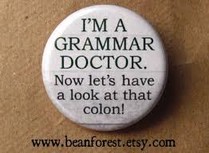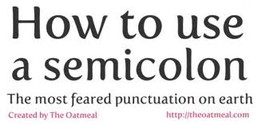Punctuation Tips & Tricks - The Grammar-Us Blog - Grammar-Us
Main menu:
A Different Kind Of Colonoscopy (And Semi-Colonoscopy)
Whoa! Wait a minute! Did you just read the word “colonoscopy” in a GRAMMAR blog? Has Grammar Girl gone off her rocker? No, not at all. It’s just my (arguably) clever way of getting your attention. Just as the medical procedure known as a colonoscopy looks into the anatomical part known as the colon and checks for abnormalities, so my grammar version of a colonoscopy (and semi- The main use of a colon in a sentence is to indicate that a list is going to follow. (Example: There were several desserts on the menu: cakes, pies, cookies, pudding and ice cream.) It might help to think of a colon as an introductory punctuation mark. A colon is made up of two periods, stacked one on top of the other, which brings to mind a pause. Perhaps you can think of it as a “drum roll” before the entrance of the sentence’s “main event” (that being the list of items that follows).
The main use of a colon in a sentence is to indicate that a list is going to follow. (Example: There were several desserts on the menu: cakes, pies, cookies, pudding and ice cream.) It might help to think of a colon as an introductory punctuation mark. A colon is made up of two periods, stacked one on top of the other, which brings to mind a pause. Perhaps you can think of it as a “drum roll” before the entrance of the sentence’s “main event” (that being the list of items that follows).
Back in the olden days, when I was going to school, we were taught that items in the list that followed a colon always should be separated by semicolons. Nowadays, however, this is not necessarily the case. It is perfectly acceptable to separate items in a list by commas, as long as those items do not, themselves, contain commas. If the list items DO contain commas, then semicolons should be used to separate them, to make reading the list easier and clearer.
For example, here is a sentence where separation of the list items by commas is correct: There were several choices of activities at the spa: exercise classes, swimming, beauty treatments and meditation sessions. Here is an example where the list needs to be separated by semicolons: Four places were listed in the newspaper article: Trenton, New Jersey; Los Angeles, California; Dallas, Texas; and Miami, Florida. As you can see, using the semicolon helps to properly group the items in the list and makes it easier for the reader to determine what they are.
Another use of the colon is to introduce a quote. When used this way, the actual quote is most often set off by indenting it on both sides (some grammarians believe that it’s acceptable to indent only on the left side). When introducing a quote with a colon, it is unnecessary to use quotation marks.
Yet another use of the colon is in salutations in formal business letters. Instead of using a comma after “Dear Mr. Smith,” you should be using a colon, if you are writing formally to him.
The final use of a colon in today’s blog post (there are others, which I will rely on your thirst for knowledge to research) is to elucidate a point being made in a sentence or title. This use of the colon is often used in book titles. For example, Hoda Kotb’s latest book is called Ten Years Later: Six People Who Faced Adversity and Transformed Their Lives. You may have noticed that I often use colons in the titles of my blog posts. The first part of the title is what I consider a “teaser,” usually an attempt to grab your attention. The second part of the title – the part that follows the colon – is a further description of what the post is going to contain.
A colon should NOT be used when the clause preceding the list ends in a verb or a preposition. (Example: The types of books I read are biography, non- Somewhat related to the colon, but serving a completely different purpose, is the semicolon. This looks like a hybrid of a period and a comma, with the period being stacked on top of the comma. Semicolons are useful little punctuation marks that are often forgotten.
Somewhat related to the colon, but serving a completely different purpose, is the semicolon. This looks like a hybrid of a period and a comma, with the period being stacked on top of the comma. Semicolons are useful little punctuation marks that are often forgotten.
The main use of a semicolon is to separate two independent clauses. Independent clauses are groups of words that can stand alone as sentences in their own right. (Example: I have always enjoyed reading; it is one of my favorite pastimes.) In the preceding example, you could easily replace the semicolon with a period and capitalize “it” to make two complete sentences.
Many times a connector word is used between the two independent clauses. Most often, these connectors are “therefore” or “however.” It is important to remember that, when using such a connector after the semicolon, the connector should be followed by a comma. (Example: It is raining today; therefore, I am not going jogging. Or: It is raining today; however, I am still going jogging.)
It is also important to note that the two halves of a sentence separated by a semicolon (i.e., the two independent clauses) should be related to each other, in terms of the idea being expressed in each one. It is incorrect to link two independent clauses with a semicolon if one of the clauses introduces a new idea into the sentence. In other words, if two separate ideas are being communicated, you should separate the independent clauses into two complete sentences, punctuated by periods.
IT is NEVER correct to separate two independent clauses by a comma (instead of a semicolon), unless a conjunction is used. (Example: It is past midnight, and I am tired. Or: I received an invitation to the meeting, but I have another appointment at that time.)
There you have it! I hope you have found this brief examination of the colon and semicolon informative, and a useful diagnostic tool for your own communications. Now, that didn’t hurt, did it?
Avoiding Apostrophe Apocolypse
Let's Pause To Honor The Comma!
- FRESH WRITING
- TWELVE ERRORS THAT MAKE A GRAMMARIAN GNASH HER TEETH
- THE WHYS AND HOWS OF WRITING AN EFFECTIVE CONSUMER LETTER
- FILLER WORDS: THE "JUNK FOOD" OF COMMUNICATIONS
- Pardon Me, Your Participle is Dangling!
- MAKE BETTER GRAMMAR A NEW YEAR’S RESOLUTION
- The Value Of Personal Letters
- How To Make Your Writing Flow
- How (And Why) To Tighten Up Your Writing
- Why Grammar Matters
- Time For Another Grammar Quiz!
- Editing: The "Make Or Break" Skill
- Proofreading: It Matters More Than You Think!
- Please Don't Ruin A Perfectly Good Tense!
- A Brave New Word
- Homophones: The Sequel
- Coulda, Shoulda, Woulda And Other Incorrectly Written Words
- More Homophones
- Time For Another Grammar Goof Quiz
- A Different Kind Of Colonoscopy (And Semi-Colonoscopy)
- Comparatives & Superlatives: The Good, The Bad, And The Ugly
- Either/Or, Neither/Nor: Decisions, Decisions!
- Let's Agree To Agree
- Avoiding Apostrophe Apocolypse
- Let's Pause To Honor The Comma!
- Three Speech Patterns That Can Compromise Professionalism
- A Hit Parade of Grammar Misses
- Negative Nancy Has Hijacked My Blog!
- Who Dat?
- Avoiding the Ill Effects of Misusing "Affect"
- How To Perfectly Use Six Irregular Verbs
- Random Ramblings
- Me, Myself and I: The Narcissist's Nightmare
- Confounding Compounds
- "All The World's A Stage...": Know Your Audience
- From The Department Of Redundancy Department: The Whole Entire Scoop On "Whole" And "Entire"
- Grammatically Challenged? There, Their, They're. It'll Be OK!
- "Its": It's a Special Exception
- We're Up And Running!